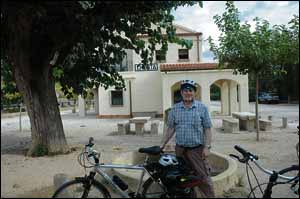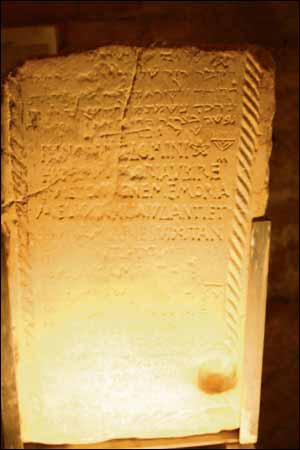 | ||||||
| Walking and cycling in the footsteps of Picasso | ||||||
I WALKED in the footsteps of the young Picasso in the place where Cubism was born and where the artist nearly died.
That was when I wasn’t cycling. But more of that later... The artist twice stayed at Horta de Sant Joan in the breathtaking Terra Alta region of Catalonia. On both occasions the sojourns had a major impact on his work. Walking the ancient, narrow streets of Horta as dusk fell and silence descended, it was not difficult to feel Picasso’s presence. In 1898, as a teenager, he contracted scarlet fever while studying at the Llotja art school in Madrid and decided to return to his native Barcelona.
Village life came as a pleasant surprise to Picasso and he actually stayed longer than intended, from June until January, 1899. He loved it and started sketching and drawing. He went on an excursion into the mountains with his friend and a donkey. While looking for somewhere to stay, Picasso fell into a river and Manuel saved him. They found a cave in which to shelter. They remained there for three weeks, living rough. Picasso and Manuel explored the surrounding area and then drew trees, rocks, goats and the Country House, but a storm destroyed almost all their work. Back in Horta, Picasso not only toiled on the land but produced oils, drawings and sketches which have proved to be the finest depiction of Horta’s characters and life at the end of the 19th century. He established a close bond with the people of Horta and the place itself.
He recalled later: “Everything I know I learned in Horta. “I experienced my purest emotions in the great Spanish forest where I retired to paint when I was 16 years old.” Ten years later he returned with his Parisian girlfriend, Fernande Olivier, an artist and model, who features in many of Picasso’s works. He attracted considerable attention with the camera he brought with him, the first to be seen in the village. The couple lodged for three months, from June to September, 1909 at the Hostal del Trompet in what was then the Plaça de Missa (now Plaça de la Iglesia). It’s still there albeit somewhat altered. Picasso was by then a well-known artist in huge demand, with art dealers eagerly awaiting his next work. In Horta, Picasso worked feverishly on landscapes, portraits and still life which proved to be some of his most representative images of cubism. Best known of the works produced while in Horta are La Bassa (The Pool), La Fabrica (The Factory), Cases Sobre un Pujol (Houses on a Hill), portraits of Fernande and the omnipresent Santa Barbara mountain.
When my invitation to visit Catalonia arrived, I responded immediately . . . without paying too much attention to the details. The fascinating Jewish history and Picasso’s connection were sufficient reason to accept. And, other than passing through the city’s airport, Barcelona itself didn’t even feature on the itinerary. Barcelona FC’s Nou Camp would have to wait until another visit to the region. Had I read the not-so-small print I would have realised that there was some fairly lengthy cycling to be undertaken. What the hell . . . in recent years I’d taken the odd cycle ride around Washington, and one marginally more strenuous in Israel’s Negev region. Other than that, a few sessions on static exercise bikes in the gym had been about my only forays in the saddle since childhood. I needn’t have worried though. I was the only one of my travelling companions who had not brought along their own helmets (I don’t own one — they all did), Headwater provided everything, including water bottles and a large saddle bag into which most cyclists possessions will fit safely and adequately.
Cycling aficionados and novices alike are supplied with machines that suit their height and weight, saddles are positioned comfortably, and there’s even a briefing about repairing punctures. All that was left to hit the open road . . . and fortunately there weren’t too many of those. Catalonia caters superbly well for cyclists with long expanses of well-finished tracks, many entirely level, with no gradient whatsoever. What of the remainder of this enchanting and inspiring region? In the MonNatura Delta there are salt flats, traditional fishing and bird-watching, including flamingos. Tortosa is a city that has begun to recognise its Jewish heritage, possibly dating back to Roman times, and renovated the old Jewish quarter. One tombstone inscription in Greek, Hebrew and Latin hints at the Roman link. But there is considerable evidence of a Jewish presence in the city particularly between the eighth and 13th centuries. The old quarter of Tortosa is very close to the Ebre, a river which has always been a natural entry from the sea to the interior of the Peninsula.
From Tortosa, I cycled alongside the Ebro through pine-scented forests, via Xerta with its old railway station. The cycle route follows the old railway line, a Via Verde (green way) for cyclists and hikers with breathtaking views of mountains. I’m surprised to discover I’m cycling past paddy fields. I’d never associated the region with rice production, but that has been the case since 1860. Some 45m kg of rice, 14 different varieties, are produced annually in the Delta. I soon reach the the Terra Alta region and the Pinell de Brai train station. There’s a chance to visit the Wine Cathedral, so called because of its vaulted cathedral-like interior. The wine cellar was built between 1918 and 1927, and designed by the architect Cèsar Martinell, a disciple of Gaudí. The old village of Miravet sits atop rocks overlooking the Ebre River, at the foot of a Templar castle. The impressive fortifications are among the largest in Catalonia. The Hotel Les Capçades in Horta de Sant Joan offers some of the best dining in the area (hotellescapcades.com).
|





